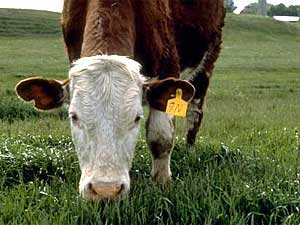|
Photos
|
 |
| Cattle in northwestern Minnesota are at risk of bovine tuberculosis. More than 100 lifestock producers gathered in Bagley this week to hear the latest on the disease outbreak. (MPR file photo) |
Bagley, Minn. — More than 100 livestock producers gathered in Bagley Tuesday to here the latest on bovine tuburculosis.
The discovery of the disease in northwest Minnesota is bad news for the state's livestock producers. Minnesota has been involved in TB eradication programs since the early 1900s. The last known case was in 1971.
This month, the federal government is expected to take away Minnesota's tuberculosis-free status. That means livestock producers in Minnesota will find it much more difficult to sell and ship cattle across state lines.
Norton Berg has a small beef cattle operation in Laporte, south of Bemidji. Berg says a lot of cattle ranchers are worried about their livelihood.
"That's a little scary," said Berg. "You have to be concerned about it. It's nice to have the tuberculosis-free status for the state, and losing that could be quite a hardship to the producers, alright."
Bovine tuberculosis is a respiratory disease caused by bacteria. It's a chronic, slowly progressive infection that's spread from animal to animal by respiratory discharge. Experts say the disease doesn't spread easily. Still, infected animals can transmit the infection to other animals even if they appear healthy.
Health officials say bovine TB can be transmitted to humans, but it's rare. Exposure to the disease through the milk or meat supply is unlikely, since milk pasteurization and adequate cooking kills the disease-causing bacteria.
Linda Glaser, a veterinarian with the Minnesota Board of Animal Health, says bovine TB is a difficult disease to eradicate.
"Cattle that are infected most of the time don't look ill, don't show any outward signs of being ill," said Glaser. "We have to rely on testing to know where the infection is. And the infection is usually spread from the movement of infected cattle, and so tracing these herds and understanding where cattle are moving, and then testing those animals, is the way we try to find the disease."
So far, hundreds of cattle in infected herds have been killed as a precaution. Nearly 50 herds have been quarantined as part of the state's investigation. Most of those showed no signs of the disease.
Officials say once the last infected herd is eliminated, the state will have to continue to test for the disease for two more years to prove it's gone. Then Minnesota can apply for reinstatement of TB-free status.
Wildlife officials are developing their own plan for dealing with the disease. Since one wild deer tested positive for TB, DNR officials have tested nearly 500 deer killed near the infected cattle operations. DNR wildlife disease specialist Michelle Powell says deer hunters in northwest Minnesota shouldn't be alarmed by the disease.
"I wouldn't say alarm or overly concerned," Powell said. "I think they should be aware of the situation and continue to cooperate with voluntarily getting their deer tested. They were wonderful this past season. They knew why we were up there. They were more than happy to come in and offer their deer to be tested."
DNR officials will allow more deer to be killed around the affected farms this year so they can be tested for the disease. Powell says the DNR will likely continue testing during deer season next fall.
Minnesota isn't the only state that's fighting bovine tuberculosis. It's also been found in Michigan, Texas, Arizona and New Mexico.
Terry Boldingh of Breckenridge is a district veterinarian with the Board of Animal Health. Boldingh says if Minnesota doesn't get rid of the disease, it could be devastating for some livestock producers.
"They depend on their cattle, whether it be dairy or beef, as probably their major source of income," said Boldingh. "So they're very, very concerned. They're an enlightened group. They've asked the right questions, the hard questions, and rightly so. This will affect probably all of them in some way or another with their markets."
So far most of the TB testing of livestock is limited to northwest Minnesota. But state officials say that may be expanded statewide.






